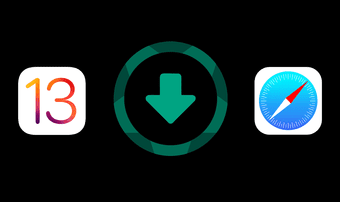Earlier, it was still possible to save certain files in Safari, provided that I was willing to dabble around with the Share Sheet. However, the introduction of a download manager makes things a whole lot easier and more convenient. If you wish to take Safari’s download manager for a spin, then allow me to share some useful tips. You can implement them to super-charge your downloading experience right away.
1. Initiate and Forget
Any downloads that you initiate in Safari are seamlessly handed over to the download manager, which then does the job regardless of whether you close your tabs or exit Safari. Sounds awesome, right? Tap on a download link, and you will receive a confirmation pop-up. Then tap Download, and you should see the Safari download manager icon show up to the right side of the address bar. A tiny progress bar should indicate the download progress. You can also tap the download manager icon to bring up the Downloads list, which displays additional information such as the size of the download. Once downloading finishes, you can preview the file right from Safari. Tap on the file within the list and it should open with a relevant program — provided that it’s in a supported format (image, document, etc.). Otherwise you will be asked to choose an app to open the file.
2. Pause Downloads
If you are on a weak internet connection, having a sizable download running in the background can slow things down further. Thankfully, you can pause your downloads, and then resume them later. Open the Downloads list, and then tap the x-shaped icon next to the download that you want to pause. Afterward, simply tap the circle-shaped icon in its place whenever you want to resume the download. You will not lose progress. Aside from pausing and resuming, you can also go about deleting an accidentally initiated download before it finishes downloading. To do that, pause the download first, and then swipe it to from right to left. Next, tap Delete.
3. Download Linked Files
You don’t have to have an actual download link or button to initiate a download in the first place. For example, you came across a link to a PDF that you can open in the browser. But rather than opening the PDF and using the Share Sheet to save it manually, there’s a better way. Simply 3D Touch or long-press the link to the PDF file, and then tap the Download Linked File option on the context menu to download it using the downloads manager instead. The same can also be done on any link regardless of whether it leads to a file or not. However, doing the same with a random link will initiate a download of the HTML file of the page. Of course, you can then open and view it (albeit with certain missing elements) even without an internet connection. Why download pages when you can just add them to the Reading List instead (option located on the same context menu)? That shows how flexible Safari’s downloads manager really is.
4. Clear Downloads List
Is the Downloads list getting out of hand? Tap the Clear icon to the top of the list to flush out the entire list, or simply swipe items individually to the left and then tap Delete. Better yet, you can configure Safari itself to clear the list for you automatically. However, you need to dive into the Settings app to do that. Step 1: On the Settings app of your iPhone or iPad, scroll down and tap Safari. On the subsequent screen, tap Downloads. Step 2: Tap Remove Download List Items. On the subsequent screen, either select After One Day or Upon Successful Download. The Safari download manager will then clear the Downloads list automatically each day or as soon as a download finishes.
5. Switch Download Location
By default, Safari’s download manager saves your files to the Downloads folder in iCloud Drive. However, you can switch to another location or use local storage easily. Start by visiting the Safari Downloads screen (Settings app > Safari > Downloads). You can tap Other to pick another location in iCloud Drive. Or tap On My iPhone/iPad to make the download manager use local storage on your iPhone or iPad. Additionally, you can also configure a third-party cloud storage service to act as the location for your downloads. Check my guide to switching download locations in Safari for more details.
6. Open Download Location
Tapping on a download within the Downloads list opens it in preview mode. But obviously, you need to get to the actual location itself when it’s time to manage your files. But instead of opening the Files app to manually locate your downloads, simply tap the magnifying glass-shaped icon next to any completed item on the list to get to the download location in a flash. After managing your files, you can go back to using your browser easily by tapping the tiny Safari label to the upper-left corner of the screen.
7. Drag and Drop Files (iPadOS Only)
If you are on an iPad, you can also drag and drop items from the Downloads list to another app quite easily. First, initiate split-view with the app. Next, open the Downloads list, and then drag and drop the file. Very handy since you can stop using the Files app altogether for such instances.
Start Downloading
Safari’s download manager is a phenomenal addition, and inarguably among the biggest improvements in a long time. Especially on the iPad, these are the kind of features that makes it a worthy laptop replacement. I hope that Apple makes Safari even better on a more continuous basis without making such implementations far and few in-between. Next up: While Safari keeps getting better, should you ditch it in favor of Brave? Time to find out from our comparison take below. The above article may contain affiliate links which help support Guiding Tech. However, it does not affect our editorial integrity. The content remains unbiased and authentic.





























